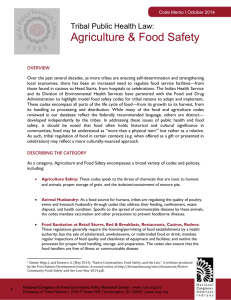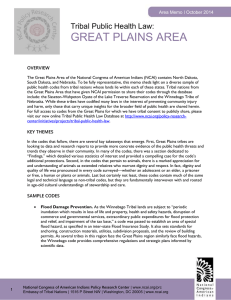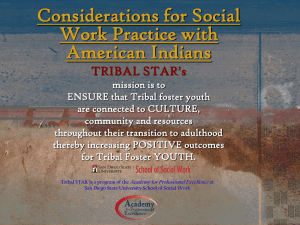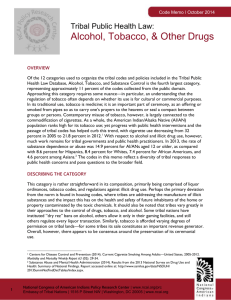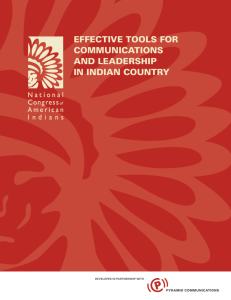Environmental Health
advertisement
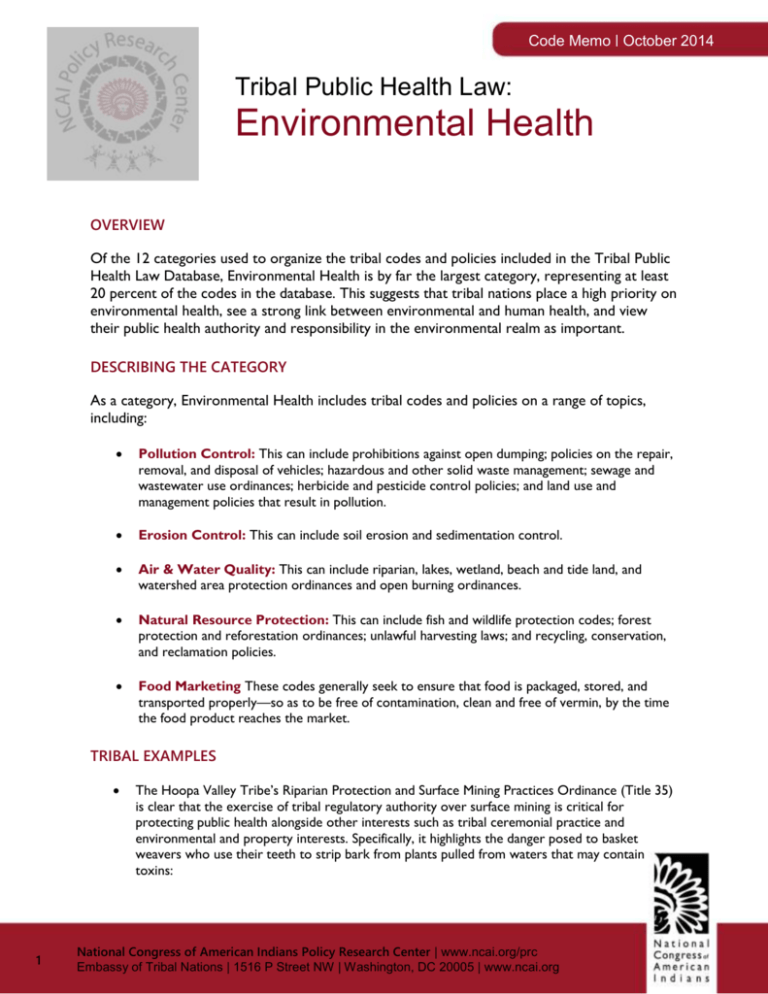
Code Memo | October 2014 Tribal Public Health Law: Environmental Health OVERVIEW Of the 12 categories used to organize the tribal codes and policies included in the Tribal Public Health Law Database, Environmental Health is by far the largest category, representing at least 20 percent of the codes in the database. This suggests that tribal nations place a high priority on environmental health, see a strong link between environmental and human health, and view their public health authority and responsibility in the environmental realm as important. DESCRIBING THE CATEGORY As a category, Environmental Health includes tribal codes and policies on a range of topics, including: Pollution Control: This can include prohibitions against open dumping; policies on the repair, removal, and disposal of vehicles; hazardous and other solid waste management; sewage and wastewater use ordinances; herbicide and pesticide control policies; and land use and management policies that result in pollution. Erosion Control: This can include soil erosion and sedimentation control. Air & Water Quality: This can include riparian, lakes, wetland, beach and tide land, and watershed area protection ordinances and open burning ordinances. Natural Resource Protection: This can include fish and wildlife protection codes; forest protection and reforestation ordinances; unlawful harvesting laws; and recycling, conservation, and reclamation policies. Food Marketing These codes generally seek to ensure that food is packaged, stored, and transported properly—so as to be free of contamination, clean and free of vermin, by the time the food product reaches the market. TRIBAL EXAMPLES 1 The Hoopa Valley Tribe’s Riparian Protection and Surface Mining Practices Ordinance (Title 35) is clear that the exercise of tribal regulatory authority over surface mining is critical for protecting public health alongside other interests such as tribal ceremonial practice and environmental and property interests. Specifically, it highlights the danger posed to basket weavers who use their teeth to strip bark from plants pulled from waters that may contain toxins: National Congress of American Indians Policy Research Center | www.ncai.org/prc Embassy of Tribal Nations | 1516 P Street NW | Washington, DC 20005 | www.ncai.org Code Memo | October 2014 WHEREAS: The Tribal Council has concluded that it is necessary to exercise comprehensive tribal regulatory authority over surface mining within the exterior boundaries of the Hoopa Valley Reservation, and over surface mining and other activities in the Trinity River and Klamath River riparian areas, in order to protect fundamental tribal ceremonial, fishery, and property interests, water quality, and the public health and safety…Beyond culturally relevant fish, the river is used for drinking water, ceremonial bathing; roots, materials, and tribal medicinal plants are gathered from the riverbank; in basket weaving, the weaver may use their teeth to strip bark pulled from the river, offering an avenue of direct exposure to water-borne toxins. The Sisseton-Wahpeton Sioux Environmental Protection Code (Chapter 61) defines as its purpose: To insure that proper and meaningful consideration of environmental and ecological factors, including the cultural, spiritual and historical aspects of those factors, is made…which may significantly affect Sisseton-Wahpeton Tribal homelands, or the health and welfare of the Sisseton-Wahpeton Sioux Tribe and its members. The Code establishes an Environmental Protection Advisory Committee, which has the authority to contract with outside firms and agencies as part of addressing its mission and a responsibility to coordinate with the Tribe’s Natural Resources Commission and Reservation Planning Commission in developing an environmental plan of action. 2 The Leech Lake Band of Ojibwe Open Burning, Burn Barrel and Fire Prevention Ordinance (No. 2006-02) is designed to “protect the welfare, peace, safety, environment, and property of the Leech Lake Reservation and its Tribal Membership…[and] to protect and preserve the natural and trust resources of the Leech Lake Reservation.” It sets out instances where a Burning Permit is required – in large part to preserve air quality and prevent forest fires – and notes that the only exceptions are for warming and food preparation fires and ceremonial fires. The Nez Perce Tribe’s Water and Sewer Utility Authority (Title 8) establishes a department with responsibility for operating and maintaining tribal public water and sewer utilities and providing essential community environmental services. There are specific provisions related to the unnecessary waste of water and the conservation of water resources, including requirements that the department itself “shall conduct operation, maintenance, and repair services in a manner that will maximize the conservation of natural, financial, and property resources.” It also gives the authority for enforcement to a Utility Board that can establish fees for service and impose sanctions and penalties. National Congress of American Indians Policy Research Center | www.ncai.org/prc Embassy of Tribal Nations | 1516 P Street NW | Washington, DC 20005 | www.ncai.org Code Memo | October 2014 NOTES FOR THE FIELD 3 Tribes see environmental health as central to public health. Many of the codes and policies frame environmental health as essential in ensuring human and cultural resource protection. There is overlap between this category and Public Health Infrastructure related to hazardous and solid waste impacts on the environment and the need for infrastructure to promote recyclables/conservation/reclamation policies and prevent widespread pollution and erosion. There is overlap between this category and the category of Emergency Planning/Management related to flood and fire control and prevention. There are other important connections between the Environmental Health category and the categories of Agriculture & Food Safety, Animal Control, Injury and Violence Prevention, and Human & Cultural Resource Protection. Several tribes have developed public nuisance laws that aim to prevent excessive noise in public spaces and littering. For instance, Sisseton-Wahpeton Sioux Penal Code (Chapter 24, 24-11-04) includes prohibitions against littering to prevent conditions that may “injure or endanger the safety, health, comfort, or propriety or his neighbors”. While these laws are often framed as important for fostering enjoyment of public environments and cultural sites, it was difficult to identify an explicit public health component. There is an open question about whether other communities are framing these issues ones related to public health. National Congress of American Indians Policy Research Center | www.ncai.org/prc Embassy of Tribal Nations | 1516 P Street NW | Washington, DC 20005 | www.ncai.org




